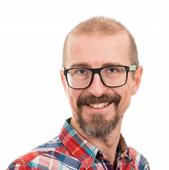Andreas Bergström
Background
I am currently an industrial PhD student at the Division of Automatic Control at the Department of Electrical Engineering at Linköping University, which I have been since 2016 when I got the opportunity to join the Wallenberg AI, Autonomous Systems and Software Program (WASP).
I received my M.Sc. degree in Electrical Engineering from Linköping University in 2005 and have since then been employed at Ericsson where, as from 2011, I am a working as a Senior Researcher at the company's research department in Linköping.
Before commencing my PhD studies, I was focusing on a variety of 5G topics inclusive of L1/L2/L3 design and concept development, evaluations and simulations, tools development (simulators and test-beds) etc. as well as concepts and tools also for LTE and 802.11/WiFi development and standardization. Prior to this, I worked between 2005 and 2011 with GSM related research and standardization, inclusive of being a 3GPP GERAN standardization delegate. During this period I was also heavily involved in the development of radio network simulators as well as in a number of performance related field trials at customer sites. During my time at Ericsson I have, apart from having supervised a number of master thesis students and summer workers, also been the co-author of quite many patents.
Research
My current research interests are within the field of radio-based localization and tracking. It is carried out in my PhD research project which is entitled Distributed autonomous systems for localization and mapping.
To this date, the focus has been on how to utilize additional information in the radio channel, which would otherwise be seen as disturbances, for the purpose of improved localization performance. This information is, to be more specific, the additional received copies of a transmitted signal due to interactions with the environment, also known as multipath propagation effects. The focus has been on the following subtopics:
- Propagation Modelling
- Any radio signal sent from a transmitter to a receiver will be affected by the environment in numerous ways such as e.g. be reflected in windows, walls and other objects, attenuated through walls, experience diffraction at edges and corners. The problem addressed is how to explicitly model the resulting signal paths given a geometrical model such as a map, without having to go all the way into e.g. complex ray-tracing procedures.
- TOA Estimation and Measurement Error Modelling
- One approach to radio-based localization is to perform trilateration in-between the object to be localized (e.g. a mobile terminal) and a number of other objects with known locations (e.g. radio base stations). This requires an estimation of the distance in-between the respective objects by means of e.g. Time-of-Arrival (TOA) measurements. These measurements will however most likely be erroneous due to the above described effect the environment has on the transmitted signals. In order to mitigate these effects, various measurement error models are proposed and their respective impact on the localization accuracy are investigated.
- The Measurements Association Problem
- As said, we want to utilize the additional information of the radio channel, i.e., the multiple received copies of the signal due to the above mentioned multipath propagation effects. This however poses the combinatorial problem of how to correctly associate a given measurement with the environment and the map information we have available. This is addressed by formulating the problem as a classical assignment problem which is solved using standard methods.
- Performance Bounds
- We also dig deeper into what theoretical localization accuracy can be anticipated, when utilizing this multipath information. This is affected by numerous aspects such as the environmental geometry, the amount of measurements used, whether combining measurements in-between objects and/or transmission directions or not, certain modelling assumptions etc.

PhD Student in Automatic Control
(Swedish: Doktorand i Reglerteknik)
- Phone:
- +46 734 180978
- E-mail:
- andreas.bergstrom_at_liu.se
- Address:
- Dept. of Electrical Engineering
- Linköping University
- SE-581 83 Linköping
- Sweden
- Visiting Address:
- Campus Valla
- Building B
- Room 2A:501 (in the A corridor on the ground floor between entrance 25 and 27)
Page responsible: Andreas Bergström
Last updated: 2019-12-04
 LiU startsida
LiU startsida
